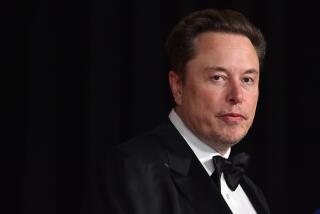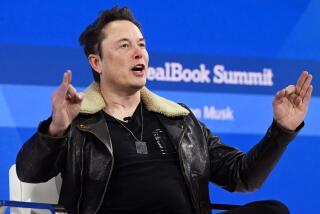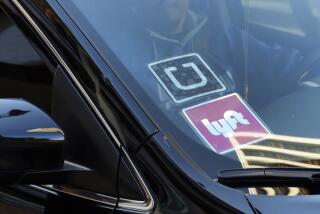Column: With Travis Kalanick out, we’ll see the real value of Uber — and it won’t be pretty

Uber CEO Travis Kalanick resigned amid concerns about his management style. (June 21, 2017) (Sign up for our free video newsletter here http://bit.ly/2n6VKPR)
- Share via
Now that its bad-boy co-founder Travis Kalanick has resigned as Uber’s CEO, the question will be asked: Is Kalanick’s departure bad for Uber, or good for Uber?
The answer is yes.
It’s good for Uber, because the company has a better chance of shedding its reputation as a howlingly bad place to work unless you’re a young white male; and its reputation for getting its way with civic officials by breaking rules, regulations and norms. These changes, if they occur, will improve its ability to recruit talented personnel, and reduce the friction — ultimately costly — that attended its truculent entry into every new market and its continuing squeeze on its 200,000 drivers.
Uber has not shown that it can profitably produce better taxi service under competitive conditions.
— Transportation expert Hubert Horan
It’s bad for Uber, because Kalanick’s messianic sales pitch obscured the fundamental unprofitability of its business model. It’s not that the company’s humongous losses were invisible, since its venture investors undoubtedly knew the numbers and the few financial reports the privately-held company dribbled out were all written in deep red.
But Kalanick had persuaded his backers and an uncritical tech press that, trust him on this, the endgame would be glorious — after all, the company was growing incredibly fast. Uber rode his self-confidence to a putative value of $70 billion. Never mind that this valuation was based only on arithmetic, derived from the meagerness of the stake in the company purchased by the latest round of investments. In the venture world, you’re only as valuable as the last round, so the next round will tell us a lot.
Ousted as CEO by Uber’s biggest investors after a string of embarrassing controversies and scandals, Kalanick will remain an Uber director and reportedly retains a commanding share of board votes. But it will be up to someone else to define Uber for the future. The search for a new CEO is underway, and that choice will be crucial. So, too, will the filling of the numerous top jobs currently vacant, including chief operating officer and chief financial officer.
But the redefinition of Uber will have to confront reality, which is far less rosy than the myth. Kalanick promoted the impression that Uber’s current success and its world-dominating future derive from the inexorable advantages of technology. The truth is that Uber’s success is based on two unsustainable tactics: subsidizing fares and exploiting drivers.
What’s the real cost of an Uber trip? The passengers don’t know, and we don’t know. That’s because customers pay only the portion of the cost shown on their Uber smartphone apps as their fare; much, if not most, of the cost is paid by the company’s venture investors — that’s where a goodly portion of their investments has been burned up.
What happens when that well runs dry? The fares will rise, and one of Uber’s selling points — its price advantage compared to yellow-cab service — will narrow or disappear.
“Uber has not shown that it can profitably produce better taxi service under competitive conditions,” says Hubert Horan, a transportation expert who has written extensively about the company at nakedcapitalism.com. “A battle between fragmented, poorly capitalized incumbents and Silicon Valley billionaires supplying billions in predatory subsidies is not neutral market competition.”
That’s just the start of the questions left over from the Kalanick regime. What if Uber has to build its self-driving car business without (allegedly) stealing the technology from Google? Or winning litigation without (allegedly) investigating the plaintiff in secret? Or winning concessions from municipal officials without (allegedly) tracking their movements covertly?
Can Uber continue to stick its drivers with heavy expenses? That’s doubtful. Uber forces drivers to cover their own fuel, maintenance, vehicle wear and tear, and insurance. Drivers begin to get this message after only a few months of working for Uber, at which point they discover that, net-net, they’re driving for something close to minimum wage. A company-funded study determined in 2015 that nearly half of its drivers drop out within a year.
Uber exploits its drivers in other ways. The company recruits as many drivers as it can in any region, then tries to manage their movement by raising fares in high-demand places or times, whether it’s rush hour, the location of a big event, or the site of an emergency. That means that in normal conditions the supply of drivers exceeds demand. That’s good for passengers, who often can summon a driver within minutes, but bad for drivers, who scramble for work. The conundrum was best expressed to me by an Uber driver in Washington, D.C., who explained that he fled the yellow-cab taxi business because of competition from Uber, only to discover as an Uber driver that he was still facing competition from Uber.
The pushback against this employment model is coming from several sources. They include state and federal labor regulators, who have been increasingly looking askance at the claim by Uber — and many other such companies — that their core employees are really only “independent contractors” working for themselves and therefore not entitled to employment rights or fringe benefits.
It’s coming from drivers themselves, who are beginning to organize (with the assistance of government officials in places like Seattle, which has passed a law allowing the drivers to unionize). It’s likely that Uber’s cost of employing drivers is destined to rise, another erosion of its business model.
The impact of those forces emerged quickly after the first signs of Kalanick’s loosened grip, the announcement last week that he would be taking a leave of absence from the CEO’s job to grieve for his recently-deceased mother and ponder his personality. As part of a “180 days of change” PR campaign, the company added a tipping function to its smartphone app, after years of refusing to countenance this benefit to drivers. Uber also narrowed the period in which customers could cancel their rides to two minutes from five, and added a charge to customers for every minute they keep a driver waiting after a brief grace period. The effect of these changes, of course, is to raise the price of an Uber trip for passengers — the first glimmer of a move toward real cost.
The most important consequence of Kalanick’s ouster as CEO may be that all these factors will get reconsidered by investors. What they may discover is that the assumptions on which Uber’s vaunted $70-billion valuation are based are just that — assumptions.
As we observed back in 2015, the financial and market arguments underlying Uber’s ambitions are based on a lot of Ifs. No one is quite sure how to measure its core market. If it’s the existing taxi business, it could be anywhere from $20 billion to $100 billion.
What’s Uber’s potential share of this market? Take a wild guess, because that’s all anyone can do. If it’s 50% of the top estimate, then Uber would capture gross revenue of $50 billion a year; if it’s 5% of the lower estimate, that number would be $4 billion. Kalanick was a master at focusing investors’ attention on the biggest estimates, but he won’t be able to do that anymore.
Kalanick also was able to communicate a Silicon Valley-centric vision of a world transformed by technology. This modest little app was capable of upending an old, inefficient transportation service model. The possibilities were limitless. That’s why we’ve seen an unending stream of pitches for “the Uber of ______” making their way through the halls of venture firms and across the pixels of technology websites. In virtually every case, the promise has turned out to be more complicated. That may be because even in Uber’s case, the promise has been more complicated.
Uber’s persona was Kalanick’s persona. Beyond question he deserves credit for the company’s growth in valuation. But it will be a mistake to think that the company’s flaws derived only from his personal shortcomings. They’re more basic, and now they will be on display, under a glaring spotlight. Be ready for a transformed Uber, and don’t be surprised if its future is less compelling, emotionally and economically, than its past.
Keep up to date with Michael Hiltzik. Follow @hiltzikm on Twitter, see his Facebook page, or email [email protected].
Return to Michael Hiltzik’s blog.







